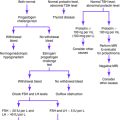Chapter 36 FEMALE SEXUAL DYSFUNCTION: DYSFUNCTION OF SEXUAL DESIRE, AROUSAL, AND ORGASM
Problems with sexual desire, arousal, and orgasm in women are very common and cause significant personal distress. The American Foundation for Urologic Disease classifies these problems as four disorders: hypoactive sexual desire disorder, sexual aversion disorder, sexual arousal disorder, and female orgasmic disorder. A discussion of each of these disorders is beyond the scope of this text. Dyspareunia is discussed in Chapter 11.
Medications That May Cause Sexual Dysfunction in Women
Key Historical Features
✓ Symptoms of systemic disease
✓ History of recreational drug use
✓ Obstetric/gynecologic history
✓ Sexual history (consider using a validated index, such as the Female Sexual Function questionnaire)
Key Physical Findings
✓ Neck examination to evaluate for thyroid nodules or a goiter
✓ Cardiovascular examination to evaluate for murmurs, abnormal heart sounds, and peripheral pulses
✓ Pulmonary examination to evaluate for crackles or wheezes
✓ Musculoskeletal examination to evaluate for disabilities that could interfere with sexual function
✓ Neurologic examination to evaluate evidence of weakness, numbness, or abnormal reflexes
Suggested Work-Up
| Measurement of follicle-stimulating hormone (FSH) and luteinizing hormone (LH) | To evaluate for hormonal imbalance and menopausal status |
| Measurement of thyroid-stimulating hormone (TSH) | To evaluate for thyroid disease |
| Measurement of prolactin level | To evaluate for hyperprolactinemia |
| Measurement of serum estradiol | To evaluate for estrogen deficiency |
| Measurements of total and free testosterone | To evaluate for testosterone deficiency |
| Measurement of fasting blood glucose | To evaluate for diabetes |
Additional Work-Up
| Measurement of dehydroepiandrosterone sulfate (DHEAS) | To evaluate for adrenal hyperplasia |
| Complete blood cell count | To evaluate for anemia |
| Liver function tests | If liver disease or liver failure is suspected |
| Measurement of blood urea nitrogen (BUN) and creatinine | If renal failure is suspected |
Basson R. Sexual desire and arousal disorders in women. N Engl J Med. 2006;354:1497-1506.
Carey JC. Pharmacological effects on sexual function. Obstet Gynecol Clin North Am. 2006;22:599-620.
Drugs that cause sexual dysfunction: an update. Med Lett Drugs Ther. 1992;34(876):73-78.
Lightner DJ. Female sexual dysfunction. Mayo Clin Proc. 2002;77:698-702.
Pauls RN, Kleeman SD, Karram MM. Female sexual dysfunction: principles of diagnosis and therapy. Obstet Gynecol Surv. 2005;60(3):196-205.
Phillips NA. Female sexual dysfunction: evaluation and treatment. Am Fam Physician. 2000;62:127-136.





